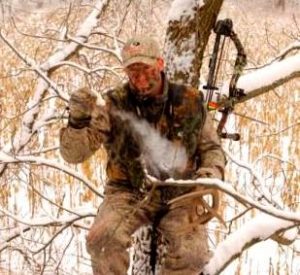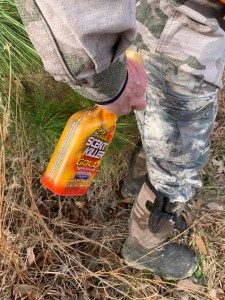 To a buck you’re a big, walking stink-ball, like Pigpen in Peanuts if you’re old enough to remember. You need to clean up your act, and we’ll get to that later. But for starters, here’s how to read and play the wind and use it to your advantage. The truth is, no matter how badly you stink you can still punch your tag if you hunt in a spot where a buck can’t smell you.
To a buck you’re a big, walking stink-ball, like Pigpen in Peanuts if you’re old enough to remember. You need to clean up your act, and we’ll get to that later. But for starters, here’s how to read and play the wind and use it to your advantage. The truth is, no matter how badly you stink you can still punch your tag if you hunt in a spot where a buck can’t smell you.
App Check
On your phone’s weather app, check the hourly for the day and times you’ll hunt. For example, say you find that the wind will be out of the W at 10 mph at 6:00 a.m, but at 8:00 it will turn NW or N. Okay, pick your stand for a W wind. If around 7:30 you feel the wind shifting around to the N as predicted, make your next decision. Either stay put because a NW wind is okay where you’re hunting, or climb down and sneak out if you think a N will spook your target buck.
Check your app/wind direction several times a day to stay one step ahead of a buck’s nose, or try to anyway.
I’ve found the wind data on most apps to be very accurate, though not foolproof. Anywhere and anytime, the wind is finicky. Plus, ridges, trees, bluffs, streams and other terrain features can affect the breeze in your hunt area. Use Weather Bug or the like as a baseline and you’ll do well, but always adapt to the true wind on the ground each day.
Wind Checker
Every 30 minutes on stand squeeze a few puffs of white powder and watch as it wafts and curls away through the woods. A lot of times you’ll see that the breeze is perfect until, say, 40 to 50 yards out from your stand, where it turns, swirls and spreads your scent in the direction where deer will most likely come from. You need to know that, especially when archery hunting. If you see a 10-pointer coming, you know to draw your bow and shoot at 30 to 35 yards, before he hits your scent and stops or spooks. Check the wind often, maybe 10 times on a sit, and act accordingly.
Thermal Ups and Downs
When the sun comes up each day, rising currents of warm air, or thermals, carry your scent particles up and away. No matter the wind’s direction the thermals will usually push your scent above any deer that show up inside shooting range between 7:00 and 11:00 a.m.
While thermals can work in your favor on a sunny morning, they can blow up in your face if you hunt too low. Never let warm, rising air carry your scent up and across a ridge or hillside where you expect to see deer. As a rule, the higher you hunt on a ridge or hill on a sunny morning, the better off you are.
As the sun sets each day slopes lose heat and the air cools. Dense, chilly air slides down hillsides and ridges and into draws and valleys. Now, flip-flop your stands or blinds. Set up downwind and slightly below a feeding area or travel funnel. The cool air ought to push your scent pool down and away from incoming deer.
You can generally predict if and when you’ll have to deal with thermals at dusk. If the wind dies late in the afternoon and dips down below 10 miles an hour, thermals will probably get tricky. But if the breeze stays steady at 15 to 20 mph, thermals will be blown away and won’t be a big deal.
Sit in the Shade—Or the Sun
Here’s your meteorological lesson for the day. When two land masses—say an oak ridge that slopes off into a dense creek bottom—are heated unequally by the sun, the air above them becomes unstable. The dense, cooler air in the shady bottom drafts toward the ground, spins and lifts up the warmer, lighter air on the edge of the ridge; it spreads, cools and falls again and again to complete the convection cycle. The circular flow continues as long as the ridge and bottom are heated unequally by the sun.
Here’s what it means. If you hunt in or near where that ridge and bottom meet and in the middle of the convection current, your scent stream will be in constant motion, and you don’t want that because your man-smell might be tumbled and tossed in multiple directions. So, avoid spots where two terrains and covers are affected in different ways by the sun. It’s better to hunt either all way up on a sunny slope or down deep in a shady bottom. In either spot the wind will be more stable and predictable.
Before each hunt:
- Shower and shampoo with an unscented soap. Dry with a clean, unscented towel. Use an odor-neutralizing deodorant and body powder.
- Launder all your clothes—underwear, socks, camouflage–in an odor-killing hunter’s detergent. Line dry outside and store garments in scent-safe bags until you’re ready to hunt.
- Wear rubber boots or leather boots lined with Scent-Lok.
- Spray cotton or fleece camouflage with an odor neutralizer like Scent Killer. Don’t forget to juice your pack, stand seat, safety harness, pull-up rope, etc.






